|
|
| |
| |
| 1927 Bentley 6½ Litre |
Chassis
No. BX2421
Engine No. DH2201
Registration No. YE 9859 |
| |
|
|
|
|
 |
 |
| December
2011 |
| Click
on thumbnail for larger view |
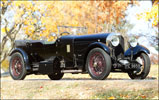 |
|
|
|
| |
 |
| |
1927 Bentley 6½
Litre Sports Tourer
Coachwork by Vanden Plas
CHASSIS NO. BX2421
ENGINE NO. DH2201
Registration No. YE 9859
Body No. 1377
$2,000,000 - $2,500,000
- An Important Vintage Bentley with
Original Coachwork
- Matching-Numbers Example
- Desirable Factory-Delivered Specifications
- The First 6 1/2-Litre Vanden Plas
Sports Tourer
- Well-Documented History Since New
- Ideal International Event Entry
- Beautiful Presentation of a Very
Significant Vintage Bentley
- 6,597 CC SOHC Inline 6-Cylinder
Engine
- Twin SU Carburetors
- 200 BHP at 3,500 RPM
- 4-Speed Manual “B” Gearbox
Upgraded to “C” Specifications
- 4-Wheel Servo-Assisted Mechanical
Drum Brakes
- Semi-Elliptical Leaf-Spring Suspension
with Friction Shock Absorbers
When assembled at the W.O. Bentley
works in late 1926, Chassis BX2421
received several desirable factory
upgrades not seen on standard cars
until the following year. These special
features included the larger 26-gallon
petrol tank and the more powerful
push-on brakes. Further outfitting
included bonnet locks, a side filler
for the petrol tank and a rev-counter.
Lastly, BX2421 received a lengthened
steering column, a rare specification
usually intended to accommodate more
unusual coachwork. As noted at Vanden
Plas on February 19, 1927, and according
to Bentley Motors’ specification,
BX2421 was slated to receive Vanden
Plas coachwork.
The coachwork chosen for BX2421 was
not that of an ordinary Vanden Plas
Tourer. Most notably, BX2421 was ordered
with aluminum paneling, helmeted fenders
and dual rear spares, all distinct
and attractive in their own right.
The scuttle was lengthened and the
rear cut short, giving the car the
aesthetics of a longer bonnet with
the four-seat body ending just over
the rear axle. In addition, the brake
lever was fitted inside the coachwork
and the lampposts were modified and
upgraded to fit stirrup-mounted Zeiss
headlamps. A Vanden Plas photograph
of the car finished in grey with black
wheels shows the striking appearance
of the big Bentley.
On the 5th of March 1927, order 1377
with Vanden Plas further called for
the driver side of the body to be
cut down to form an “arm rest.”
Additionally, the double rear-spare
carrier was altered and a large trunk
was added at the rear. A locker was
fitted to the driver side, the steps
were reduced in width, a center-folding
armrest was specified for the back
seat and all doors were to have pockets.
A flat petrol tank guard was fitted,
and lastly, the car was delivered
with down cushions, a full set of
side curtains and a screen wiper.
BX2421 was unquestionably expensive
and undoubtedly intended for long-distance
touring and, by the time of its completion,
the car was sold to its first owner,
E. Bullivant of Mortimer House in
London. BX2421 is also noteworthy
as the first 6 1/2 Litre delivered
with a Vanden Plas Sports Tourer body.
The car saw regular service with Bentley
Motors throughout 1928, during which
it received many mechanical updates,
including coil ignition and an updated
carburetor. 1928 also marked the changing
of early 6 1/2 Litre dynamo configuration,
moving the unit to the front of the
crankshaft.
In 1929, Mr. Bullivant part-traded
BX2421 to London Rolls-Royce and Bentley
agent Jack Barclay for a new Speed
Six Saloon. As a dedicated customer,
Mr. Bullivant went on to purchase
yet another new Bentley in 1931, an
8 Litre Saloon. An invoice from Jack
Barclay to Richard Winsloe dated June
13, 1929, marks the sale of BX2421
and a transfer of guarantee. Having
traded in his 4 1/2 Litre Tourer,
the 6 1/2 Litre purchase required
an additional £300.
Upon Mr. Winsloe’s purchase of
the Bentley, a service was performed
during which the mileage was noted
to be 17,443. As expected, the car
had been a long-distance tourer. Further
maintenance continued and, in approximately
one year, Mr. Winsloe had covered
just 5,000 miles. In 1930, the car
received the updated Bluemel spring
steering wheel and, after some engine
work, the mileage was set to zero.
In 1931, BX2421 received a new front
axle assembly at the factory.
After Rolls-Royce purchased Bentley
Motors in 1931, maintenance records
continued, but the work was often
conducted by Birkin & Couper.
In the case of BX2421, they were tasked
with making the desirable upgrade
of modifying the original “B”
gearbox with the 3rd and top gear
of a “C” Box.
In 1936, after seven years in Mr.
Winslow’s ownership, the car
was sold to C. Burrage- Moulton of
Leverstock Green, near Hemel Hempstead
in the UK. In 1949, BX2421 changed
hands to Dr. M.H. Harding and later
to A.J.L. Evans, G.S. Baigent and
N.S. Gibbons in 1957, 1963 and 1964
respectively. In 1966, the car was
sold to E.C. Lynch who brought it
to the US. G. Hoff purchased the car
in 1971, followed by C.F. Brown in
1979 and M. Triggs in 1981.
In 1983, BX2421 subsequently found
its way into the hands of Irene Laidlaw.
After decades of private ownership,
the car was offered to the public
in 1990 and made its way back into
a private collection in England. In
1991, W.H. Wrather purchased the car
from C. Pettit and the Stratford Motor
Museum.
Throughout its post-war life, BX2421
saw the replacement of its wings with
the more standard Vanden Plas long
wings and the fitting of a standard
rear-wheel carrier but, prior to its
public sale two decades ago, the car
appeared again with helmet-style wings
and a trunk at the rear. BX2421 has
also received the sensible upgrading
of carburetion to run the Speed Six
dual-SU configuration.
Upon close inspection, one will discover
the great originality of the coachwork
and, as with all Vanden Plas coachwork,
the body number 1377 is stamped in
numerous places on the wood framing.
The gauges, lamps and other ancillary
hardware are either original or correct.
Against the firewall under the dash,
one can find an exceptionally rare
and original insulated pad, which
still shows the changing of the dynamo
in 1929. For a Bentley expert, BX2421
is exceptionally correct and the original
details are a delight to see.
BX2421 remains a matching-numbers
example carrying its original body
and the first of just five 6 1/2 Litre
models built with open Vanden Plas
coachwork. This car stands as one
of just a handful of surviving original-bodied,
matching-numbered 6 1/2 Litres. BX2421
is without question one of the most
exceptional Bentleys in the world.
BX2421 is accompanied by Bentley factory
and Vanden Plas records, as well as
other documentation from its more
recent service history. Featured in
numerous Bentley publications, BX2421
has remained an important example
of the marque. Today, BX2421 is handsomely
finished in black over green leather
and, having seen regular maintenance
over the last decade, is likely be
a strong event entry where its immense
torque and long legs are sure to impress.
A worthy example for the finest collection,
this is a Bentley not to be missed.
This car is 'sold' as of Dec 26,
2011.
|
|
| |
|
|
| |
|
|
| |
Source:
Gooding & Company
Posted: Dec 27, 2011 |
|
| |
|
|
|
|
 |
 |
| August
2011 |
| Click
on thumbnail for larger view |
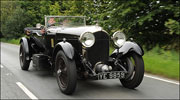 |
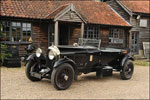 |
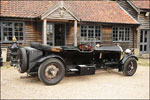 |
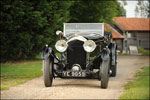 |
 |
 |
 |
 |
 |
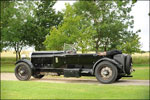 |
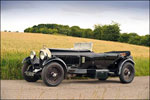 |
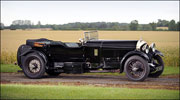 |
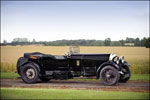 |
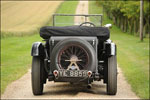 |
 |
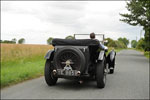 |
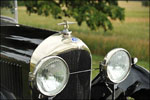 |
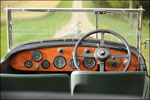 |
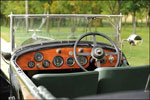 |
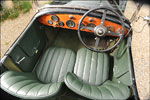 |
 |
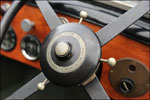 |
 |
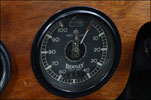 |
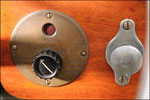 |
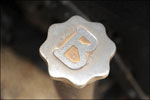 |
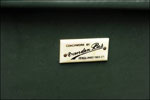 |
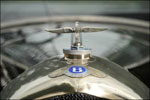 |
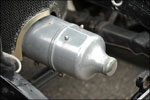 |
 |
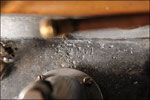 |
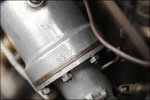 |
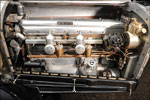 |
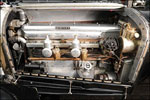 |
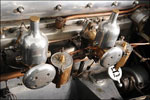 |
 |
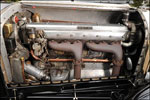 |
|
|
|
| |
 |
| |
One of the
most significant Vintage Bentleys
to be offered for sale in more than
20 years
1927 Bentley 6½ Liter Sports
Tourer
Coachwork by Vanden Plas
Chassis no. BX 2421
Engine no. DH 2201
Body no. 1377
This magnificent Bentley is widely
acknowledged as being one of the finest
of its breed, it was commissioned
by a true connoisseur of the marque,
E. Bullivant, who tailored its unique
sporting coachwork which it still
retains to this day, together with
all of its major components.
This car benefits from a known and
documented history from new. Copies
of the Bentley Factory records and
Vanden Plas order both exist, and
these combined with knowledge of its
original owner's verve and taste for
Bentleys confirm that it has always
been a very special automobile, because
it was designed that way.
It was sold new to E. Bullivant of
Mortimer House, Egerton Gardens, a
substantial town house in London's
Knightbridge/Chelsea area. He was
a gentleman known to have always commissioned
the most up to date, sporting and
good looking cars from Bentley Motors.
Despite carrying a guarantee date
of March 1927, it was fitted from
new with the later pattern push-on
brakes and a 26 gallon tank, features
which would only become standard for
the following year. It was equipped
with a long steering column, no doubt
owing to the necessary rake for its
coachwork and at the stern a 3 liter
exhaust fishtail finished it off.
The requirements to Vanden Plas were
equally detailed, the body was paneled,
rather than fabric, was designed with
an armrest for the driver (as for
a team car), it was to have side lockers,
a trunk at its rear and a double spare
wheel carrier. Full weather protection
was required and it had pockets to
all the doors. By the time it was
finished with accessories including
bold Zeiss headlamps, the total cost
of the body alone was nearly twice
that of a standard VDP body.
Keeping up with the development of
the model, Bullivant had the car uprated
within his first year of ownership,
when it gained the new radiator and
crankshaft driven dynamo set up, camshaft
damper and 'new type carb'. Even when
Bullivant exchanged the car at Jack
Barclay for a newer love in 1929,
its next owner R. Winsloe kept the
car maintained by the factory, and
continued updates with high speed
oil pump gears, a sprung steering
wheel, rear hydraulic shock absorbers
to the rear and a Spicer shaft, as
well as converting it to a C type
'box with the help of Birkin &
Coupers of Welwyn.
Its chassis maintenance records continue
right up to 1939, charting the next
owner as C. Burrage-Moulton in 1936.
The car's subsequent ownership trail
is recorded from that day until this,
as: Dr. M.H. Harding (1949), A.J.L.
Evans (1957), G.S. Baigent (1963),
N.S. Gibbons (1964), to the U.S. and
E.C. Lynch (1966), G. Hoff (1971),
C.F. Brown (1979) at which point it
returned to the U.K. to M. Triggs
(1981), I. Laidlaw (1983) and then
C. Pettit (1988). In this period its
carburetion was uprated by highly
regarded Bentley specialist Richard
Moss with the fitment of early Speed
Six pattern twin SU units.
The car was last seen publicly in
the zenith of the 1980s market, when
Bonhams Chairman Robert Brooks and
Head of the Motoring Department James
Knight assembled one of the finest
auctions of British Sports Cars ever
to take place, in Monaco. Shortly
after this it passed into a private
British collection of exceptionally
high quality automobiles, emerging
recently for its sale.
Condition
Over the course of its life any
minor details altered have been returned
to its original form with a sympathetic
eye for detail and by known Bentley
specialists. Endorsing its originality
are period photos from day one, including
in its even better looking 1928 onwards
guise with front engine driven dynamo,
confirming that it was always in the
desirable configuration in which it
is today. The car is pictured in the
standard reference work for this era
of Bentley, Hay's Bentley - The
Vintage Years (page 93), and in
a report completed by the author on
the car in the mid-1980s its conclusion
is that this 'is probably one of the
most desirable 6½ Liters in
existence'. Hay recently reviewed,
updated and endorsed this with a current
report that accompanies the car. Recent
research during cataloging by Bonhams
has re-confirmed its matched numbers
status, including its bodywork and
the presence of original detail features
such as the rear hydraulic shocks,
so often lost over time.
In preparation for the auction, the
Bentley has been freshly serviced
and detailed by respected California
restorer Alan Taylor of Alan Taylor
Company, Inc. in Escondido. Aesthetically,
it represents an older restoration,
its interior, paint and wheels displaying
a light patina the like of which suits
these brazen war horses and is frequently
created artificially on lesser cars.
On the road, the performance is still
exhilarating; the six cylinders provide
a surge of power with a reassuring
and solid sensation that there is
always more to come as the engine
sings through the rev range.
Survival
Vintage Bentleys tended to have hard
lives, either in their early days
as those who emulated the famed Bentley
Boys had a tendency for the 'red mist'
to come down and over exert themselves
behind the wheel resulting in accidents,
or else, later on their coachwork
was updated or butchered to maintain
the use of their indestructible running
gear for a more practical purpose.
The cars were frequently altered to
become hearses or ambulances, tow
trucks and the like, and while the
old photos of noble Bentleys being
used for more mundane tasks are somewhat
entertaining, they are tinged with
the sadness that so many great cars
have gone by the wayside, particularly
during the war.
Quantifying these numbers makes it
all the more sobering. While it is
a common misconception that all Bentleys
were Vanden Plas Tourers, the reality
is far from it, particularly on the
six cylinder car. Of 544 6½
liter chassis built, only 48 were
tourers at all! Of those, Vanden Plas
were the favorite choice, but only
19 cars received their open coachwork
including the Works Le Mans cars,
the remainder being shared by Cadogan,
H.J. Mulliner, Hooper, Harrison, Wylder
and others. Of that 19, a dozen of
the cars survive at all, and of those
only 9 retain their original bodywork.
A cursory glance through that roster
crystallizes the 'carpe diem' moment
that the sale of this fine automobile
presents.
Summary
Today, the usability of an original
bodied, matched numbers Vintage Bentley
is multi-faceted, it could be shown
on a concours field anywhere in the
world, will provide a comfortable
long distance driving or touring on
the many events for which it is eligible
or even exercised on the track that
the Bentley marque established the
reputation in the 1920s - Le Mans.
With its known pedigree, a fascinating
file of correspondence and archive
material that even includes a copy
of Winsloe's purchase invoice from
Jack Barclay in 1929, and its sheer
robust elegance it is easy to see
why this car is so revered and desired
in Bentley circles.
This car is for sale as of August
19, 2011.
|
|
| |
|
|
| |
|
|
| |
Source:
Bonhams
Posted: Aug 19, 2011 |
|
| |
|
|
|
|
 |
 |
| 2006 |
| In
England in 2006 / Owned by a BDC member |
 |
|
 |
| Click
on thumbnail for larger view |
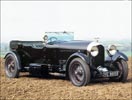 |
|
|
|
| |
 |
| |
1927 BENTLEY
6½-LITRE FOUR-SEAT Tourer
COACHWORK BY Vanden Plas
Reg. No. YE 9859; Chassis No. BX 2421;
Engine No. DH 2201
'This was a Six-Cylinder Bentley,
and what a wonderful thing to handle
it was, I do not think I have driven
a car that was so beautifully balanced...
A thing of beauty indeed, and, I should
imagine, a joy for pretty nearly ever.'
The Tatler, London, January
11th, 1928.
After its successful one model policy
based on the 3-litre chassis, Bentley
decided to add a larger car to appeal
to buyers in the Rolls-Royce price
league. Their 6½-litre chassis,
unveiled at the Olympia Show in the
autumn of 1952, could accelerate happily
from 3 to 80 m.p.h. in top gear and
reach 65 m.p.h. from 10 m.p.h. in
third gear in a little under 30 seconds.
The 6½-litre and its similar
but more highly tuned Speed Six sister
were available until 1930, by which
time a mere 363 of the former and
181 of the latter had been built.
In standard tune the engine produced
more power than the Hispano-Suiza
H6 and was of course, able to develop
even more in race trim. Two victories
at Le Mans and a Brooklands Double
Twelve were just a few of the engine's
many successes.
This 6½-litre has Speed Six
carburation and Le Mans pattern exhaust
manifolds so presumably develops more
than standard power. It was built
without the camshaft vibration damper,
fitted to most cars, and for this
reason, apparently, it was thought
mechanically rough by previous owners
so it had little use. Six years ago
a damper was fitted which has completely
transformed the car's refinement.
The hood and tonneau are serviceable,
as is the majority of the black paintwork.
The present owner, who has had possession
since early 1988, has carried out
further work on the car. This has
included the fitting of original-style
helmet type wings, side mounted boxes
(doubling as steps), and a rear luggage
truck onto which twin spare wheels
are mounted. The original Vanden Plas
body has been resprayed in black,
and the interior is finished in green
leather.
The car was supplied in 1927 to E.
Bullivant and is thought to have spent
the greater part of its post-war life
in America, until re-imported in 1982.
Comprehensive notes exist on its pre-war
history, as well as more recent bills
pertaining to the work carried out
in 1983.
This is an extremely desirable car,
made all the more rare by having its
original Vanden Plas bodywork. It
comes with a V5 registration document
and has a U.K. MoT test certificate
valid until November 1989.
|
|
| |
|
|
| |
|
|
| |
Source:
Christie's Auction of Jaguar, Aston
Martin, Lagonda and Bentley Automobiles
in Monaco catalog, May 3, 1989
Posted: Dec 29, 2006 |
|
| |
|
|
|
|
 |
| Click
on thumbnail for larger view |
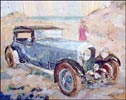 |
|
|
|
| |
 |
| |
1927 Bentley Roadster
— c1960s by Dallasta.
|
|
| |
|
|
| |
|
|
| |
Source:
Unknown
Posted: Sep 05, 2006 |
|
| |
|
|
|
|
 |
|
|
 |
|
|
 |
|
|
|
|
 |
| EARLIEST
RECORD OF HISTORICAL FACTS & INFORMATION |
 |
 |
| |
| Chassis No. |
BX2421 |
| Engine No.
|
DH2201 |
| Registration
No. |
YE 9859 |
| Date of Delivery: |
Mar 1927 |
| Type of Body: |
4-seater |
| Coachbuilder:
|
Vanden Plas |
| Type of Car: |
ST2  |
| |
|
| First Owner: |
BULLIVANT E |
|
|
| |
|
|
| |
More Info:
Michael Hay, in his book Bentley:
The Vintage Years, 1997, states:
"Long steering column, 26 gallon
tank, side filler AT rev counter. 3
litre Speed Model tail pipe. Vanden
Plas body no. 1377, still fitted." |
|
| |
|
|
| |
|
|
| |
Posted: Mar 01, 2007 |
|
| |
|
|
|
|
| |
| |
| |
| Submit
more information on this car |
| |
| |
| |
|
|
| |
| |
| |
 |
| |
| |
|
| |
|
 |
 |
 |
Sep 30, 2020 - Info and photograph received from Simon Hunt for Chassis No. RL3439 |
 |
 |
Sep 30, 2020 - Info and photographs received from Dick Clay for Chassis No. 147 |
 |
 |
Sep 29, 2020 - Info and photographs received from Ernst Jan Krudop for his Chassis No. AX1651 |
 |
 |
Sep 28, 2020 - Info and photographs received from Lars Hedborg
for his Chassis No. KL3590 |
 |
 |
Sep 25, 2020 - Info and photograph added for Registration No. XV 3207 |
 |
 |
Sep 24, 2020 - Info and photograph added for Registration No. YM 7165 |
 |
| [More] |
 |
|
|
|
 |
|
|
 |
 |
 |
|
CLUB TALK
Upcoming Vintage Bentley Events |
 |
|
|
 |
 |
 |
|
|
 |
| |
|